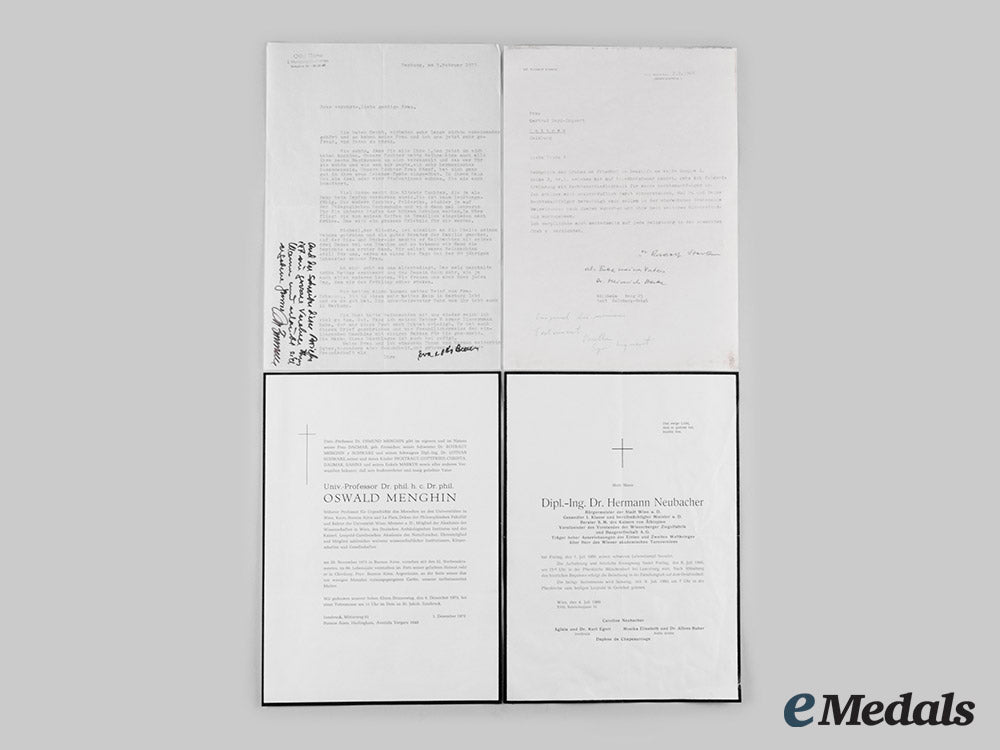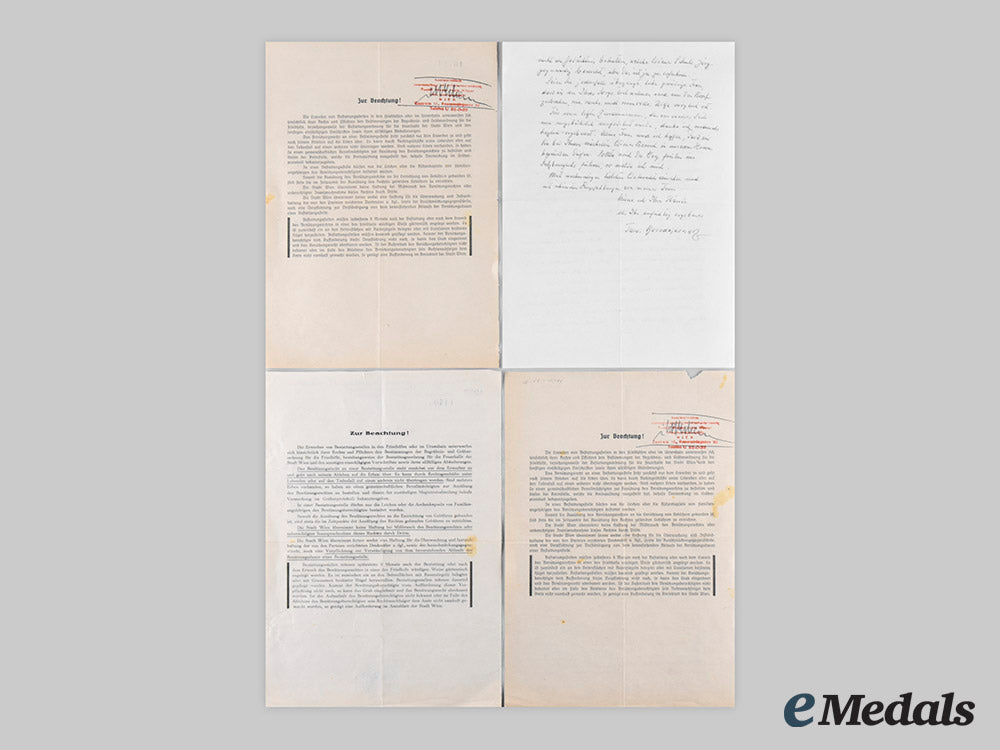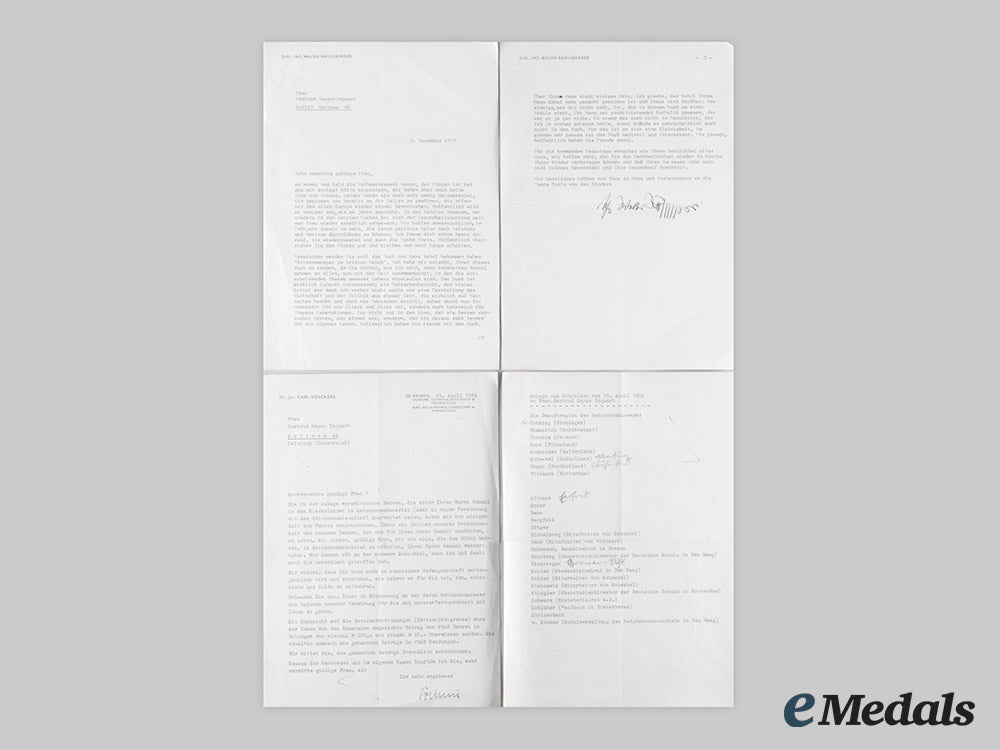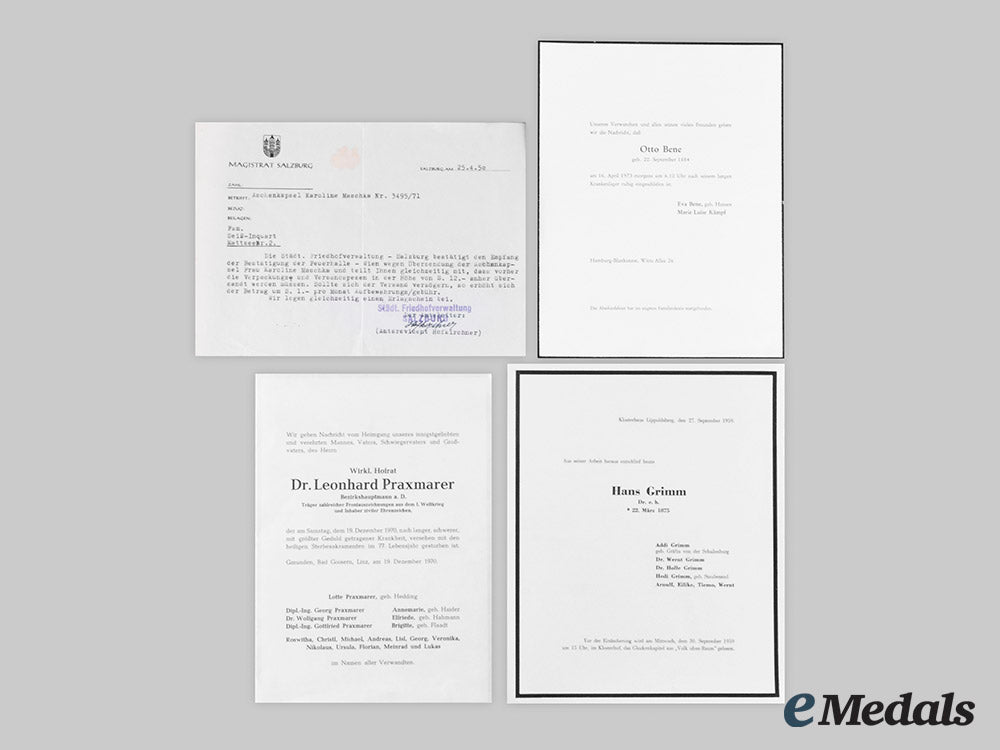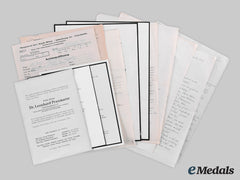
LOADING ...
In response to evolving domestic opinion, eMedals Inc has made the conscious decision to remove the presentation of German Third Reich historical artifacts from our online catalogue. For three decades, eMedals Inc has made an effort to preserve history in all its forms. As historians and researchers, we have managed sensitive articles and materials with the greatest of care and respect for their past and present social context. We acknowledge the growing sentiments put forth by the Canadian public and have taken proactive actions to address this opinion.
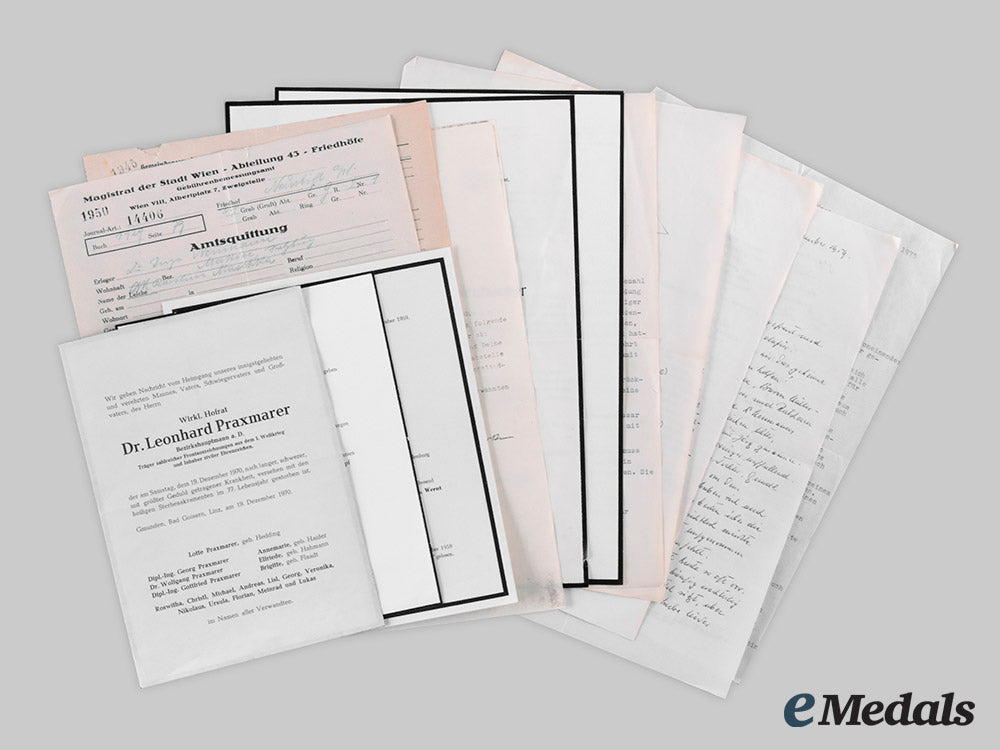
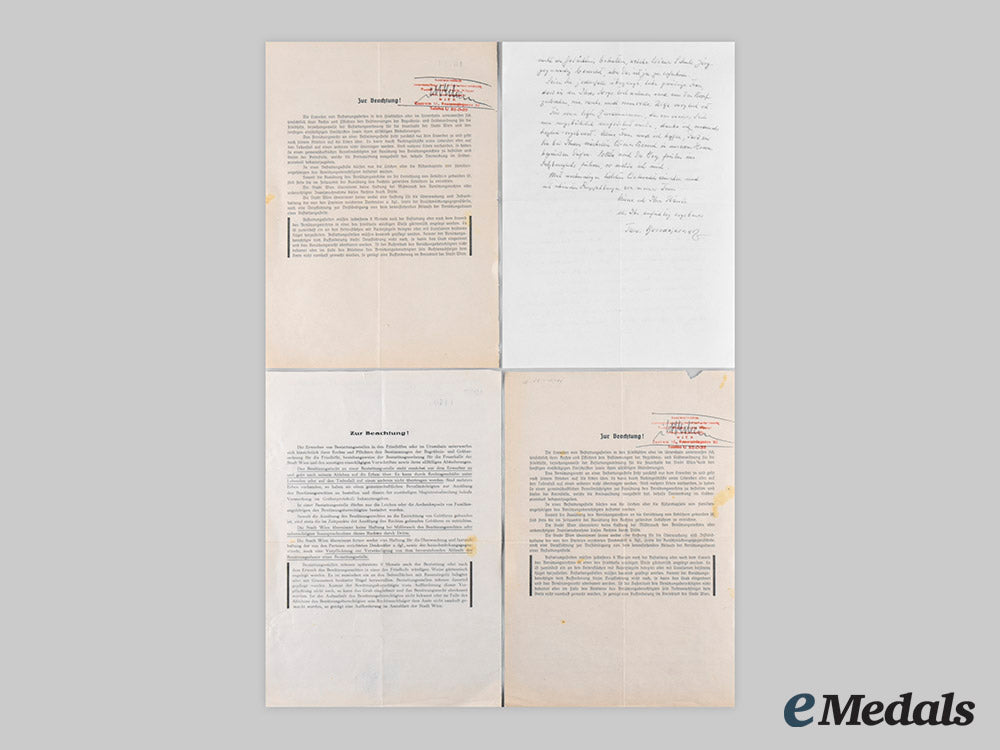
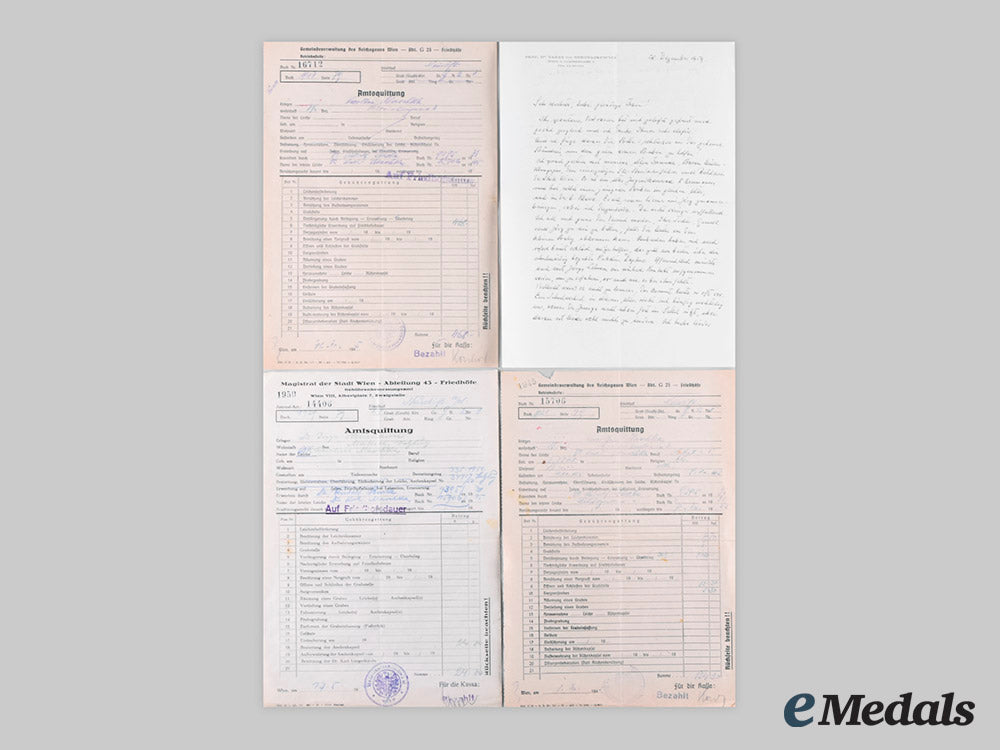
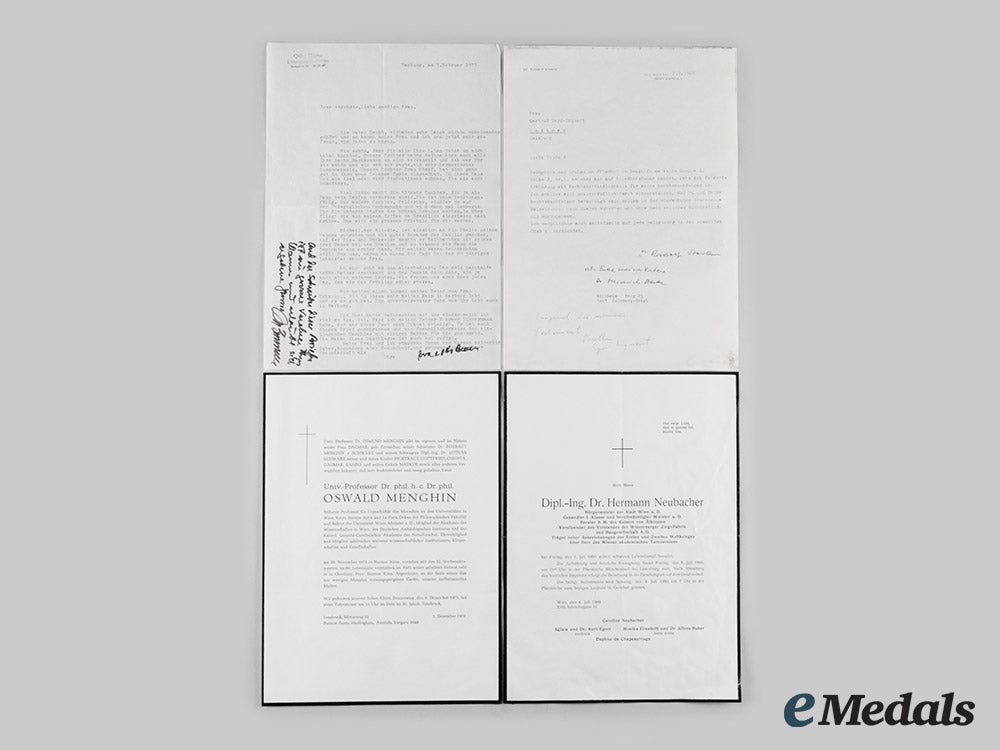
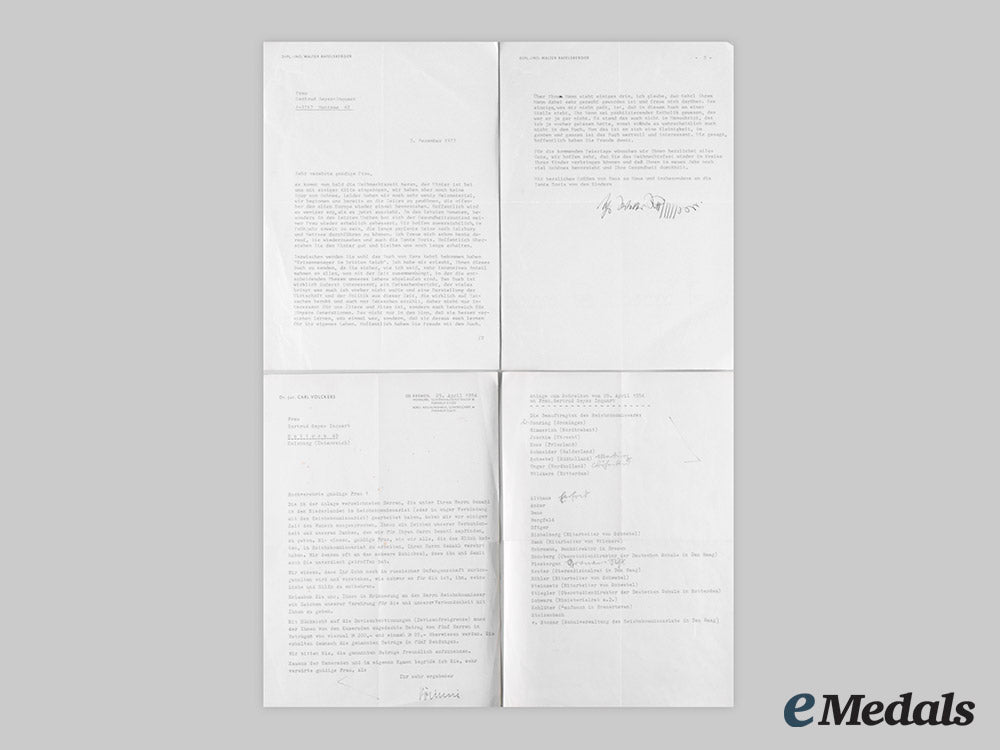
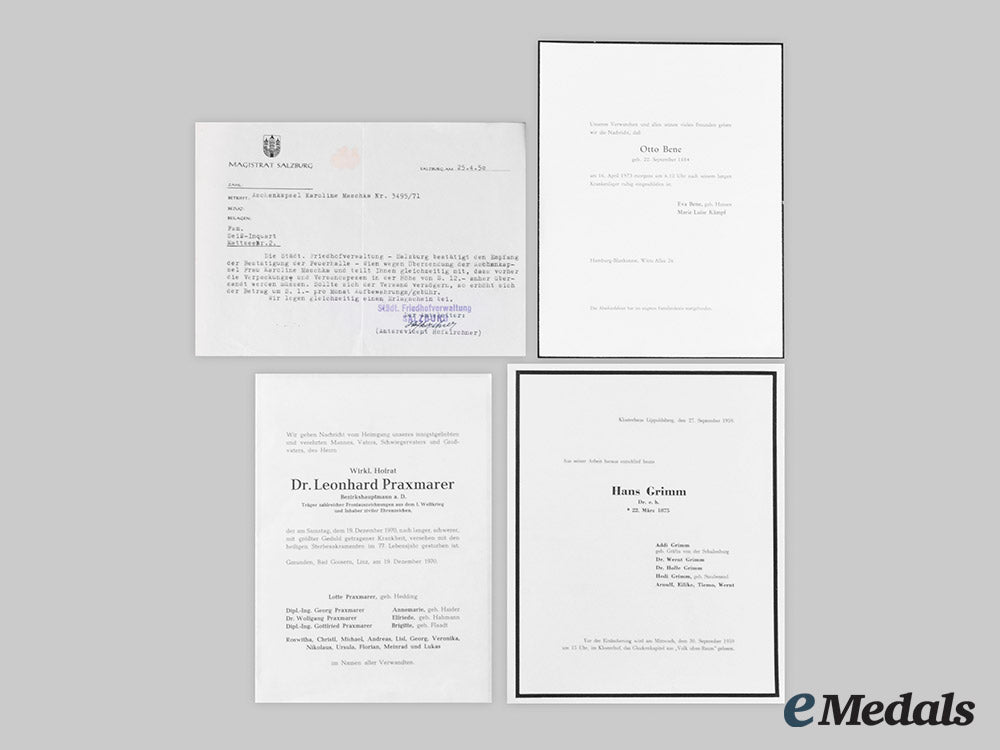
Germany, Nsdap. A Lot Of Letters & Obituaries Of Former Nsdap Members From The Estate Of Widow Of Seyß-Inquart
Germany, Nsdap. A Lot Of Letters & Obituaries Of Former Nsdap Members From The Estate Of Widow Of Seyß-Inquart
SKU: ITEM: G45772
Current Bid:
Your Max Bid:
Bid History:
Time Remaining:
Couldn't load pickup availability
Shipping Details
Shipping Details
eMedals offers rapid domestic and international shipping. Orders received prior to 12:00pm (EST) will be shipped on the same business day.* Orders placed on Canadian Federal holidays will be dispatched the subsequent business day. Courier tracking numbers are provided for all shipments. All items purchased from eMedals can be returned for a full monetary refund or merchandise credit, providing the criteria presented in our Terms & Conditions are met. *Please note that the addition of a COA may impact dispatch time.
Shipping Details
eMedals offers rapid domestic and international shipping. Orders received prior to 12:00pm (EST) will be shipped on the same business day.* Orders placed on Canadian Federal holidays will be dispatched the subsequent business day. Courier tracking numbers are provided for all shipments. All items purchased from eMedals can be returned for a full monetary refund or merchandise credit, providing the criteria presented in our Terms & Conditions are met. *Please note that the addition of a COA may impact dispatch time.
Description
Description
The collection consists of: A letter to Gertrud Seyß-Inquart from Dr. Carl Völckers (1886-1970), from 1940 to 1945 commissioner of the city of Rotterdam in the occupied Netherlands. Dated to Bremen on April 29, 1954, signed in blue ink. Völckers included a list of people that worked under Arthur Seyß-Inquart in the occupied Netherlands and states that due to their unbroken admiration for him they want to send Gertrud, who is struggling with financial issues, 885 Deutsche Mark. Measuring 210 mm (w) x 297 mm (h), presenting two folding creases and light creasing of the edges, remains very fine.
A letter to Gertrud from Walter Rafelsberger (1899-1989), Austrian state commissioner for the corporate sector and as such responsible for the “Aryanisation” of companies. Dated to December 5, 1973, signed in black ink. Rafelsberger recommends a book to Gertrud, written by former NSDAP economist Hans Kehrl, called “Krisenmanager im Dritten Reich” (crisis manager in the Third Reich).
Measuring 210 mm (w) x 297 mm (h), presenting two folding creases and some overall creasing, remains near very fine.
A letter to Gertrud from Prof. Taras von Borodajkewycz (1902-1984), an Austrian national socialist historian. Dated to December 20, 1959, signed in blue ink.
Measuring 209 mm (w) x 295 mm (h), presenting two folding creases and minimal scuffing of the edges, remains near extremely fine.
A letter to Gertrud from Otto Bene (1884-1973), an NSDAP diplomat in the occupied Netherlands and SS-Brigadeführer. In the early 1930s, he was the NSDAP’s local group leader for the city of London, England, and later the NSDAP leader of Great Britain and Ireland. Dated Hamburg on February 5, 1973, signed in black ink.
Measuring 209 mm (w) x 296 mm (h), presenting two folding creases and light creasing of the edges, remains near very fine.
Otto Bene’s obituary, measuring 157 mm (w) x 203 mm (h), presenting a folding crease and light creasing of the edges, remains better than very fine.
The obituary of Hans Grimm (1875-1959), national socialist author.
Measuring 175 mm (w) x 215 mm (h), presenting a folding crease and light creasing of the edges, remains better than very fine.
The obituary of Dr. Hermann Neubacher (1893-1960), Austrian economist and from 1938 to 1940 mayor of Vienna, later special commissioner in Greece and Serbia.
Measuring 209 mm (w) x 296 mm (h), presenting two folding creases and some overall creasking, remains near very fine.
The obituary of Prof. Oswald Menghin (1888-1973), Austrian NSDAP historian, responsible for the “Aryanisation” of the University of Vienna after the Anschluss.
Measuring 210 mm (w) x 296 mm (h), presenting two folding creases and light creasing of the edges, remains better than very fine.
The obituary of Dr. Leonhard Praxmarer, in all likelihood related to Konrad Praxmarer, cousin of Gertrud Seyß-Inquart.
Measuring 148 mm (w) x 209 mm (h), presenting one folding crease and light creasing of the edges, remains better than very fine.
A grouping of funeral documents for Karolin and Karl Maschka, in all likelihood the parents of Gertrude Seyß-Inquart, née Maschka, dated to 1945 and 1950 respectively.
Measuring 210 mm (w) x 296 mm (h), presenting two folding creases and some creasing and fraying of the edges, remaining better than fine.
Footnote: Arthur Seyß-Inquart was born on July 22, 1892 in the village of Stannern (present-day Stonařov, southern Czech Republic) near the town of Iglau (Jihlava). This was a German speaking community within a Czech dominated area in Moravia, at the time part of the Austro-Hungarian empire. The family moved to Vienna in 1907.
Seyß-Inquart began to study law at the university of Vienna, and earned his degree during the First War in 1917 while recovering from being wounded. As a soldier in the Austro-Hungarian army he saw action in Russia, Romania, and Italy. He received several bravery decorations and at the end of the war held the rank of Oberleutnant (first lieutenant).
After the war, Seyß-Inquart developed close ties with several right wing and fascist organisations, among them the Vaterländische Front (Fatherland Front). He became a successful lawyer and had his own practice since 1921. In 1933, Seyß-Inquart went into Austrian politics and joined the cabinet of chancellor Engelbert Dollfuß.
Through growing influence and support by non other than A.H. himself, Seyß-Inquart eventually became Austrian Minister of the Interior in February of 1938. With the looming annexation of Austria by Germany in March of the same year, Austrian chancellor Schuschnigg stepped down. Seyß-Inquart was chosen as his successor due to immense pressure applied on the Austrian government by the NSDAP.
He served in this position for less than two days, until the Anschluss was completed. Seyß-Inquart signed the documents that legalised the annexation of Austria by Germany. After his office had ceased to exist, he was named Reichsstatthalter (Reich Governor) of the Ostmark, the newly created province that Austria had become as part of Greater Germany.
Being a fanatical anti-Semite, Seyß-Inquart almost immediately ordered the confiscation of Jewish property and had the Austrian Jews sent to concentration camps. He received the honorary SS rank of Gruppenführer in May of 1939, and would go on to become an SS-Obergruppenführer in 1941.
After the attack on Poland at the beginning of the Second War, Seyß-Inquart was named deputy to Hans Frank, the General Governor of occupied Poland. He supported Frank in the deportation of Polish Jews. Seyß-Inquart was also aware of the systematic murder of Polish intellectuals by the German secret service “Abwehr”.
In May of 1940, A.H. named Seyß-Inquart Reich Commissioner of the Netherlands. His policies concerning the Dutch Jews were no different than his policies had been concerning the Jews in Austria and Poland, in that they were ousted from governmental, and leading press and industry positions, their property seized, before being sent to concentration camps. Of the 140,000 Jews that were registered in the Netherlands in 1941, only 30,000 survived the war.
During his reign of terror, Seyß-Inquart also authorized the execution of at least 800 people, ranging from political prisoners to resistance fighters. At the end of the war, he was arrested by Allied forces and became one of the 24 defendants during the Nuremberg trials against the major war criminals. Seyß-Inquart was found guilty in three out of four charges and executed by hanging on October 16, 1946.
Description
The collection consists of: A letter to Gertrud Seyß-Inquart from Dr. Carl Völckers (1886-1970), from 1940 to 1945 commissioner of the city of Rotterdam in the occupied Netherlands. Dated to Bremen on April 29, 1954, signed in blue ink. Völckers included a list of people that worked under Arthur Seyß-Inquart in the occupied Netherlands and states that due to their unbroken admiration for him they want to send Gertrud, who is struggling with financial issues, 885 Deutsche Mark. Measuring 210 mm (w) x 297 mm (h), presenting two folding creases and light creasing of the edges, remains very fine.
A letter to Gertrud from Walter Rafelsberger (1899-1989), Austrian state commissioner for the corporate sector and as such responsible for the “Aryanisation” of companies. Dated to December 5, 1973, signed in black ink. Rafelsberger recommends a book to Gertrud, written by former NSDAP economist Hans Kehrl, called “Krisenmanager im Dritten Reich” (crisis manager in the Third Reich).
Measuring 210 mm (w) x 297 mm (h), presenting two folding creases and some overall creasing, remains near very fine.
A letter to Gertrud from Prof. Taras von Borodajkewycz (1902-1984), an Austrian national socialist historian. Dated to December 20, 1959, signed in blue ink.
Measuring 209 mm (w) x 295 mm (h), presenting two folding creases and minimal scuffing of the edges, remains near extremely fine.
A letter to Gertrud from Otto Bene (1884-1973), an NSDAP diplomat in the occupied Netherlands and SS-Brigadeführer. In the early 1930s, he was the NSDAP’s local group leader for the city of London, England, and later the NSDAP leader of Great Britain and Ireland. Dated Hamburg on February 5, 1973, signed in black ink.
Measuring 209 mm (w) x 296 mm (h), presenting two folding creases and light creasing of the edges, remains near very fine.
Otto Bene’s obituary, measuring 157 mm (w) x 203 mm (h), presenting a folding crease and light creasing of the edges, remains better than very fine.
The obituary of Hans Grimm (1875-1959), national socialist author.
Measuring 175 mm (w) x 215 mm (h), presenting a folding crease and light creasing of the edges, remains better than very fine.
The obituary of Dr. Hermann Neubacher (1893-1960), Austrian economist and from 1938 to 1940 mayor of Vienna, later special commissioner in Greece and Serbia.
Measuring 209 mm (w) x 296 mm (h), presenting two folding creases and some overall creasking, remains near very fine.
The obituary of Prof. Oswald Menghin (1888-1973), Austrian NSDAP historian, responsible for the “Aryanisation” of the University of Vienna after the Anschluss.
Measuring 210 mm (w) x 296 mm (h), presenting two folding creases and light creasing of the edges, remains better than very fine.
The obituary of Dr. Leonhard Praxmarer, in all likelihood related to Konrad Praxmarer, cousin of Gertrud Seyß-Inquart.
Measuring 148 mm (w) x 209 mm (h), presenting one folding crease and light creasing of the edges, remains better than very fine.
A grouping of funeral documents for Karolin and Karl Maschka, in all likelihood the parents of Gertrude Seyß-Inquart, née Maschka, dated to 1945 and 1950 respectively.
Measuring 210 mm (w) x 296 mm (h), presenting two folding creases and some creasing and fraying of the edges, remaining better than fine.
Footnote: Arthur Seyß-Inquart was born on July 22, 1892 in the village of Stannern (present-day Stonařov, southern Czech Republic) near the town of Iglau (Jihlava). This was a German speaking community within a Czech dominated area in Moravia, at the time part of the Austro-Hungarian empire. The family moved to Vienna in 1907.
Seyß-Inquart began to study law at the university of Vienna, and earned his degree during the First War in 1917 while recovering from being wounded. As a soldier in the Austro-Hungarian army he saw action in Russia, Romania, and Italy. He received several bravery decorations and at the end of the war held the rank of Oberleutnant (first lieutenant).
After the war, Seyß-Inquart developed close ties with several right wing and fascist organisations, among them the Vaterländische Front (Fatherland Front). He became a successful lawyer and had his own practice since 1921. In 1933, Seyß-Inquart went into Austrian politics and joined the cabinet of chancellor Engelbert Dollfuß.
Through growing influence and support by non other than A.H. himself, Seyß-Inquart eventually became Austrian Minister of the Interior in February of 1938. With the looming annexation of Austria by Germany in March of the same year, Austrian chancellor Schuschnigg stepped down. Seyß-Inquart was chosen as his successor due to immense pressure applied on the Austrian government by the NSDAP.
He served in this position for less than two days, until the Anschluss was completed. Seyß-Inquart signed the documents that legalised the annexation of Austria by Germany. After his office had ceased to exist, he was named Reichsstatthalter (Reich Governor) of the Ostmark, the newly created province that Austria had become as part of Greater Germany.
Being a fanatical anti-Semite, Seyß-Inquart almost immediately ordered the confiscation of Jewish property and had the Austrian Jews sent to concentration camps. He received the honorary SS rank of Gruppenführer in May of 1939, and would go on to become an SS-Obergruppenführer in 1941.
After the attack on Poland at the beginning of the Second War, Seyß-Inquart was named deputy to Hans Frank, the General Governor of occupied Poland. He supported Frank in the deportation of Polish Jews. Seyß-Inquart was also aware of the systematic murder of Polish intellectuals by the German secret service “Abwehr”.
In May of 1940, A.H. named Seyß-Inquart Reich Commissioner of the Netherlands. His policies concerning the Dutch Jews were no different than his policies had been concerning the Jews in Austria and Poland, in that they were ousted from governmental, and leading press and industry positions, their property seized, before being sent to concentration camps. Of the 140,000 Jews that were registered in the Netherlands in 1941, only 30,000 survived the war.
During his reign of terror, Seyß-Inquart also authorized the execution of at least 800 people, ranging from political prisoners to resistance fighters. At the end of the war, he was arrested by Allied forces and became one of the 24 defendants during the Nuremberg trials against the major war criminals. Seyß-Inquart was found guilty in three out of four charges and executed by hanging on October 16, 1946.


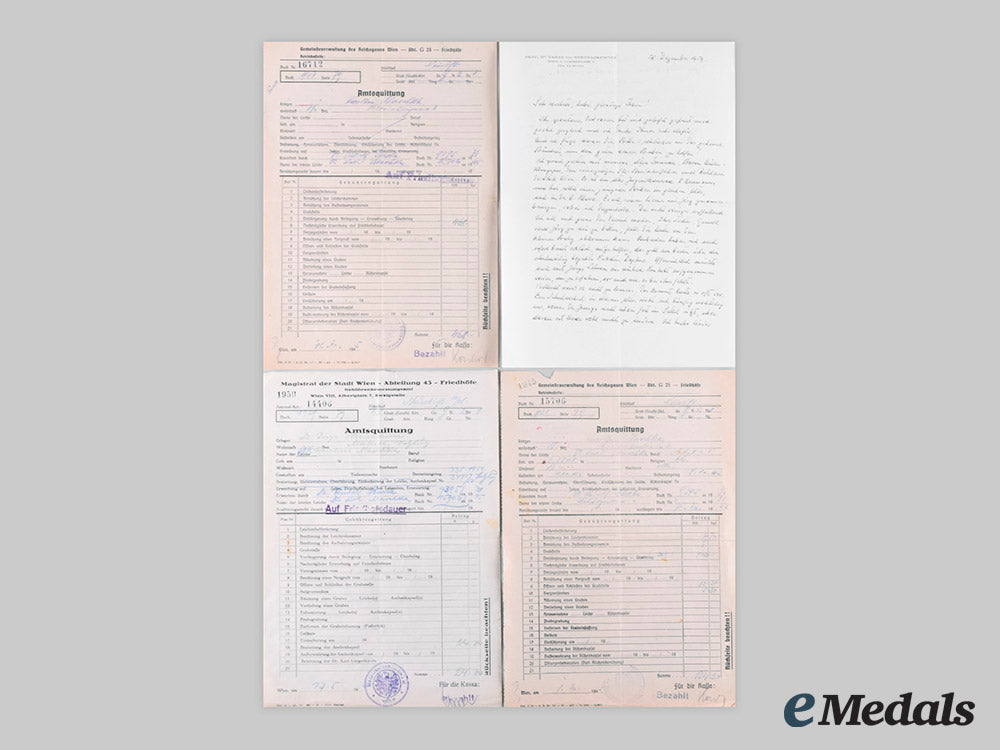


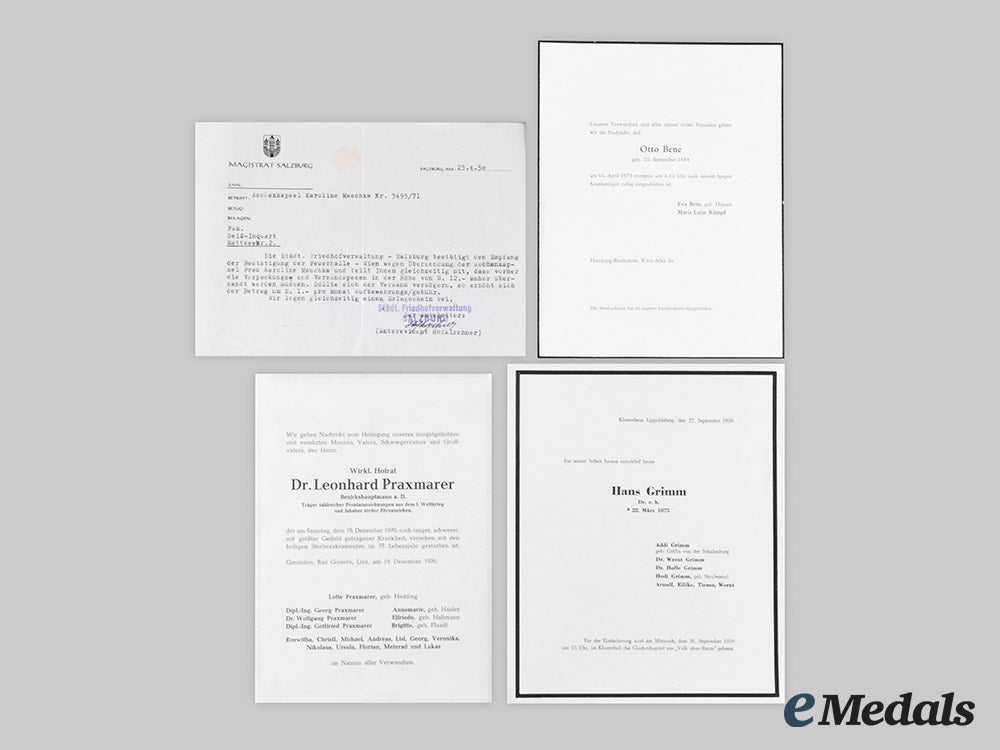
You May Also Like
Germany, Third Reich. A Mixed Lot of Tyrolean Marksmanship Badges
G52930
Germany, SS. An Estonian Waffen-SS Volunteer’s Sleeve Shield
G50381
Germany, SS. A Waffen-SS Sturmmann Sleeve Insignia
G52846
Germany, Third Reich; Slovakia, First Republic. A Mixed Lot of Wartime Postcards
G52905
Germany, Third Reich. A Pair of Tyrolean Marksmanship Badges
G52981
-
Germany, Third Reich. A Mixed Lot of Tyrolean Marksmanship Badges
G52930
Add to CartRegular price $135 USDRegular price $0 USD Sale price $135 USDUnit price / per -
Germany, SS. An Estonian Waffen-SS Volunteer’s Sleeve Shield
G50381
Add to CartRegular price $150 USDRegular price $0 USD Sale price $150 USDUnit price / per -
Germany, SS. A Waffen-SS Sturmmann Sleeve Insignia
G52846
Add to CartRegular price $135 USDRegular price $0 USD Sale price $135 USDUnit price / per -
Germany, Third Reich; Slovakia, First Republic. A Mixed Lot of Wartime Postcards
G52905
Add to CartRegular price $135 USDRegular price $0 USD Sale price $135 USDUnit price / per -
Germany, Third Reich. A Pair of Tyrolean Marksmanship Badges
G52981
Add to CartRegular price $135 USDRegular price $0 USD Sale price $135 USDUnit price / per
Do you have a similar item you are interested in selling?
Please complete the form and our client care representatives will contact you.
Sell Item


